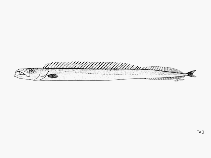http://www.fishbase.org/Summary/speciesSummary.php?genusname=Paradiplospinus&speciesname=antarcticus ---> http://192.134.151.83/Summary/speciesSummary.php?genusname=Paradiplospinus&speciesname=antarcticus
http://192.134.151.83/Summary/speciesSummary.php?genusname=Paradiplospinus&speciesname=antarcticus ---> https://fishbase.mnhn.fr/Summary/speciesSummary.php?genusname=Paradiplospinus&speciesname=antarcticus
https://fishbase.mnhn.fr/Summary/speciesSummary.php?genusname=Paradiplospinus&speciesname=antarcticus ---> https://fishbase.mnhn.fr/summary/Paradiplospinus-antarcticus.html
Paradiplospinus antarcticus, Antarctic escolar

You can
sponsor
this page
Common name (e.g. trout)
Genus + Species (e.g. Gadus morhua)
-

-
About this page
-
Languages
-
User feedbacks
-
Citation
-
Uploads
-
Related species
-


 Antarctic escolar
Add your observation in
Fish Watcher
Upload your
photos
and
videos
Antarctic escolar
Add your observation in
Fish Watcher
Upload your
photos
and
videos
Pictures
|
Google image
 Paradiplospinus antarcticus
Paradiplospinus antarcticus
Picture by
FAO
Teleostei (teleosts) >
Scombriformes
(Mackerels) >
Gempylidae
(Snake mackerels)
Etymology:
Paradiplospinus:
Greek, para = the side of + Greek, diploos = double + Latin, spina, pinna = thron (Ref.
45335
)
.
More on author:
Andriashev
.
Issue
Validity of species questionnable for some authors, but no recent publications.
Environment: milieu / climate zone / depth range / distribution range
Ecology
Marine; bathypelagic; depth range 0 - 2830 m (Ref.
6181
). Deep-water; 31°S - 79°S, 180°W - 180°E (Ref.
6181
)
Southern Ocean: circumpolar. In the belief that there was only a single species of
Paradiplospinus
, many authors used the name
Paradiplospinus gracilis
as including
Paradiplospinus antarcticus
.
Size / Weight / Age
Maturity: L
m
?
range ? - ? cm
Max length : 52.0 cm SL male/unsexed; (Ref.
6181
); common length : 35.0 cm SL male/unsexed; (Ref.
6181
)
Dorsal
spines
(total): 36 - 39;
Dorsal
soft rays
(total): 24-34;
Anal
spines
: 2;
Anal
soft rays
: 25 - 31;
Vertebrae
: 64 - 67. Body is extremely elongate. Mouth with fang-like teeth, 3-6 fangs anteriorly in upper jaw and 1 fang on each side of the lower jaw. Pyloric caeca 6. Color is silvery white without any conspicuous marks except 40 - 50 narrow longitudinal lines of pale melanophores; the dorsal-fin base, opercular region and caudal-fin origin dark brownish.
Adults and subadults epipelagic to mesopelagic, or mesobenthopelagic at shelves and slopes from surface to 830 m (temp. 0° to 4°C). Larvae and juveniles, probably mesopelagic to bathypelagic, down to 2,830 m depth (Ref.
5084
). Feeds on krill, squid and fishes (predominantly myctophids). Larval and juvenile specimens mostly obtained between southern land masses and the Antarctic continent.
Life cycle and mating behavior
Maturity
|
Reproduction
|
Spawning
|
Eggs
|
Fecundity
|
Larvae
Nakamura, I. and N.V. Parin
, 1993. FAO Species Catalogue. Vol. 15. Snake mackerels and cutlassfishes of the world (families Gempylidae and Trichiuridae). An annotated and illustrated catalogue of the snake mackerels, snoeks, escolars, gemfishes, sackfishes, domine, oilfish, cutlassfishes,. scabbardfishes, hairtails, and frostfishes known to date. FAO Fish. Synop. 125(15):136 p. (Ref.
6181
)
IUCN Red List Status (Ref.
130435
)
Not Evaluated
CITES
Not Evaluated
Not Evaluated
Threat to humans
Harmless
Human uses
Fisheries: of no interest
FAO - Publication:
search
|
FishSource
|
More information
Countries
FAO areas
Ecosystems
Occurrences
Introductions
Stocks
Ecology
Diet
Food items
Food consumption
Ration
Common names
Synonyms
Metabolism
Predators
Ecotoxicology
Reproduction
Maturity
Spawning
Spawning aggregation
Fecundity
Eggs
Egg development
Age/Size
Growth
Length-weight
Length-length
Length-frequencies
Morphometrics
Morphology
Larvae
Larval dynamics
Recruitment
Abundance
BRUVS
References
Aquaculture
Aquaculture profile
Strains
Genetics
Electrophoreses
Heritability
Diseases
Processing
Nutrients
Mass conversion
Collaborators
Pictures
Stamps, Coins Misc.
Sounds
Ciguatera
Speed
Swim. type
Gill area
Otoliths
Brains
Vision
Tools
E-book
|
Field guide
|
Identification keys
|
Length-frequency wizard
|
Life-history tool
|
Point map
|
Classification Tree
|
Catch-MSY
|
Special reports
Check for Aquarium maintenance
|
Check for Species Fact Sheets
|
Check for Aquaculture Fact Sheets
Download XML
Summary page
|
Point data
|
Common names
|
Photos
Internet sources
AFORO (otoliths)
|
Aquatic Commons
|
BHL
|
Cloffa
|
BOLDSystems
|
Websites from users
|
Check FishWatcher
|
CISTI
|
Catalog of Fishes
:
genus
,
species
|
DiscoverLife
|
ECOTOX
| FAO - Publication:
search
|
Faunafri
| Fishipedia |
Fishtrace
| GenBank:
genome
,
nucleotide
|
GloBI
|
Google Books
|
Google Scholar
|
Google
| IGFA World Record |
MitoFish
|
National databases
|
Otolith Atlas of Taiwan Fishes
|
PubMed
| Reef Life Survey | Socotra Atlas |
Tree of Life
| Wikipedia:
Go
,
Search
| World Records Freshwater Fishing |
Zoobank
|
Zoological Record
Estimates based on models
Preferred temperature (Ref.
123201
): 0.8 - 7.8, mean 3.5 °C (based on 694 cells).
Phylogenetic diversity index (Ref.
82804
): PD
50
= 0.7500 [Uniqueness, from 0.5 = low to 2.0 = high].
Bayesian length-weight: a=0.00363 (0.00163 - 0.00807), b=3.10 (2.91 - 3.29), in cm total length, based on LWR estimates for this (Sub)family-body shape (Ref.
93245
).
Trophic level (Ref.
69278
): 4.1 ±0.53 se; based on food items.
Resilience (Ref.
120179
): Medium, minimum population doubling time 1.4 - 4.4 years (Preliminary K or Fecundity.).
Fishing Vulnerability (Ref.
59153
): Moderate to high vulnerability (45 of 100).
Back to Search
Random Species
Back to Top
Accessed through:
Not available
FishBase mirror site :
localhost
Page last modified by :
mrius-barile
- 20 July 2016
Fatal error
: Uncaught ArgumentCountError: Too few arguments to function checkEcotox(), 1 passed in /var/www/html/summary/speciessummary.php on line 2304 and exactly 3 expected in /var/www/html/includes/speciessummary.lib.php:2579 Stack trace: #0 /var/www/html/summary/speciessummary.php(2304): checkEcotox() #1 {main} thrown in
/var/www/html/includes/speciessummary.lib.php
on line
2579
|